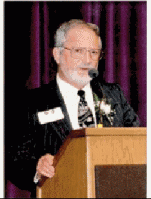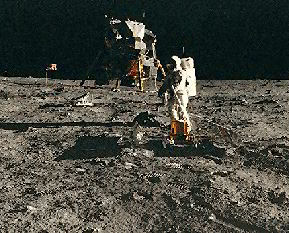Join the Northern California Northern Nevada Section of the American Association of Physics Teachers at our Fall Meeting/Conference

Friday, October 9 and Saturday, October 10, 2009
Friday Evening Social
6:00-8:30 PM at Paul Robinson’s Home (directions)
Guest of Honor: Sy Liebergot, Flight Controller of Mission Control during Apollo Program
Saturday Meeting/Conference
Conference Center, NASA Ames, Moffett Field, CA
From Highway 101: 1. Exit Moffett Blvd./NASA Parkway. 2. At the stop sign just short of the NASA Ames gate, turn right into the conference center parking lot.Friday Evening Social
6:00-8:30 PM Hot Dog Reception
 Complimentary Hot Dogs (beef or tofu) and Beer at “Rancho Robinson”
Complimentary Hot Dogs (beef or tofu) and Beer at “Rancho Robinson”
424 Quartz Street; Redwood City, CA 94062 (directions)
Guest of Honor: Sy Liebergot, Flight Controller of Mission Control during Apollo program.
Sy will share some of his experiences with the filmmakers and actors of Apollo 13. He will also be available to autograph books and answer questions what it was like to be one of the central players on the mission control team–during good times and bad.
Saturday Meeting/Conference
Conference Center, NASA Ames, Moffett Field, CA
From Highway 101: 1. Exit Moffett Blvd./NASA Parkway. 2. At the stop sign just short of the NASA Ames gate, turn right into the conference center parking lot.8:00 Registration, Coffee, Donuts and other culinary delights.
8:55 Welcome and Announcements
9:00 Show and Tell
Share your favorite demonstration or teaching tip. Since new teachers and section members will be at this meeting, veterans are encouraged to dust off some of your oldies but goodies. If you have handouts, please bring 75 copies. PASCO will present their latest products. Time limit is 5 minutes person, or you risk the dreaded gong.
9:45 “Transit Tracks: NASA’s Kepler Mission”
 Edna DeVore
SETI Institute; edevore@seti.org
Edna DeVore
SETI Institute; edevore@seti.org
Using a model of a planet transiting a star, students learn what a transit is, under what conditions a transit may be seen, and what effects a planet’s size and distance from its star have on transit behavior. Students interpret graphs of brightness vs time to deduce characteristics of a star-planet system. Demonstration, hand-outs, and NASA Kepler Mission poster provided.
10:00 Invited Speaker: “The Search for Habitable Worlds”
 Natalie Batalha
NASA Ames and San Jose State University; nbatalha@science.sjsu.edu
Natalie Batalha
NASA Ames and San Jose State University; nbatalha@science.sjsu.edu
NASA’s Kepler Mission has begun its 3.5-year quest for habitable planets like Earth in our galaxy. Natalie will define habitability from the perspective of the Kepler science team and describe how and where the spacecraft will look for worlds reminiscent of our own. She will give an overview of what to expect in the coming years as we work to understand whether Earth-like planets in our galaxy are common or rare.
11:00 Keynote Speaker: Sy Liebergot; EECOM Mission Flight Controller for Apollo
www.apolloeecom.com This year is the 40th Anniversary of the Apollo program that culminated with landing on the moon. N Cal/Nev AAPT is pleased to commemorate mankind’s greatest adventures with a special appearance of Sy Liebergot.
This year is the 40th Anniversary of the Apollo program that culminated with landing on the moon. N Cal/Nev AAPT is pleased to commemorate mankind’s greatest adventures with a special appearance of Sy Liebergot.
Sy will speak about what it was like to be a Mission Flight Controller when a monster failure occurred during the Apollo 13 mission and landed squarely in his lap. He relates the general details of the explosion as they really happened.
Sy will also speak about Ethics in Engineering, using the real examples of the Apollo 1 pad fire disaster and the Shuttle Challenger and Columbia space disasters as subjects for this presentation. He describes how he and his fellow Apollo mission flight controllers approached their part in the successful lunar landings in an ethical manner. Sy uses real-life examples that convey in a way realistic and memorable enough to train engineers to deal with the heart-wrenching decisions some of them will have to make, particularly when they become managers. He examines how ethics (or the diminution of) played a role in the three tragedies of the U.S. space program: the Apollo 1 pad fire, the in-flight destruction of Shuttle Orbiters Challenger and Columbia.
Sy will be available for book signings after his talk.
12:30 Lunch at NASA Ames
Video replay of the LCROSS lunar impact from the Oct. 9 morning
1:30 Business Meeting
Look, only 30 minutes long!
2:00 Invited Talk: “Taking a Ride on the Wild Side: The Successful Stardust Sample Return Mission to Comet 81P/Wild 2”
 Scott Sandford
NASA Ames, ssandford@mail.arc.nasa.gov
Scott Sandford
NASA Ames, ssandford@mail.arc.nasa.gov
In 2006, NASA’s STARDUST Mission successfully returned samples from Comet 81P/Wild 2 to the Earth for study. The spacecraft was launched in 1999 and on January 2, 2004 it made a close flyby (236 km) of the nucleus of Comet Wild 2 (pronounced “Vildt Two”). During the flyby the spacecraft collected samples of dust from the coma of the comet. These samples were returned to Earth on January 15, 2006 after which they receiving a preliminary six month examination to establish the basic nature of the returned samples. The samples were then turned over to the NASA Curatorial Office where they have since been available to the general worldwide scientific community for continued study.
Scott is one of the original Co-Investigators and Science Team members of the STARDUST mission and was on the team that recovered the Sample Return Capsule from the Utah desert. He also escorted the capsule to NASA-Johnson Space Center, assisted with the removal of the samples from the capsule, and led the Preliminary Examination Team responsible for studying the organic materials in the returned samples. Samples have confirmed some of the ideas we had about comets and the origin of our Solar System, and completely overturned others.
3:00 End of program
3:00 Canceled “Shooting the Moon: Precision Tests of General Relativity with APOLLO
 Charles Hoyle
Humboldt State University; charles.hoyle@humboldt.edu
Charles Hoyle
Humboldt State University; charles.hoyle@humboldt.edu
It has been nearly forty years since the first reflectors were placed on the lunar surface by the Apollo astronauts. Laser ranging to these mirrors provides high-precision tests of General Relativity, as well as a host of information about the lunar ephemeris. APOLLO (the Apache Point Observatory Lunar Laser-ranging Operation) recently obtained the first ranges with millimeter precision, representing an order-of-magnitude improvement over previous efforts. In the near future, this enhanced performance will provide unprecedented tests of the Strong Equivalence Principle, the best measure of the constancy of the gravitational constant, G, the most stringent limitations on predicted deviations of the gravitational inverse-square law, and information about the lunar environment. We discuss the techniques employed by APOLLO, initial results, and expected sensitivity.
Logistics
Registration
Fee is waived for first-time attendees and students! Everyone else pays only $20 — which includes lunch. A bargain at twice the price!
Registration can be completed on Saturday morning.
Lodging
Local hotels include (in no particular order):
Comfort Inn Redwood City 1818 El Camino Real Redwood City, CA 94063 800-444-6835 $80+/nightor
Days Inn Palo Alto-Stanford 4238 El Camino Real Stanford, CA 94306 800-346-8357 $69+/nightor Comfort Inn Palo Alto Stanford University 3945 El Camino Rreal Palo Alto, CA 94306 800-346-8357 $85+/night
or DAmerica’s Best Inn 1090 El Camino Real Redwood City, CA 94063 800-346-5357 $70+/night
or Travelodge Palo Alto 3255 El Camino Real Palo Alto, CA 94306 800-346-8357 $74+/night
or Mermaid Inn 727 El Camino Real Menlo Park, CA 94025 650-323-9481 $76+/night
Be First to Comment